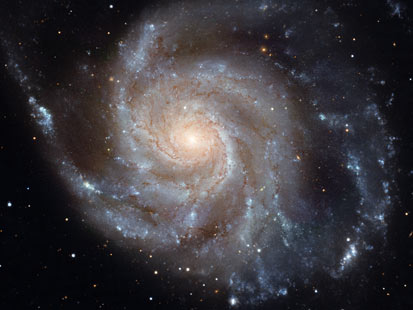Supernova Near Big Dipper: How to Watch

The Pinwheel Galaxy, seen by the Hubble Telescope. STScI/hubblesite.org
( Note: Thanks to several of you. Our photo department, a bit overburdened yesterday, provided the wrong image, and I didn’t catch the error either. An image of the real Pinwheel Galaxy has been posted above in its place.)
Twenty-one million light years away — right next door when you consider the size of the universe — something unspeakably violent has happened. A star has died, exploding into what astronomers call a supernova.
That’s the bad news. The good news is that it’s sufficiently far away that we earthlings can see it through a telescope, if you know where to look and have a bit of patience.
It was first spotted Aug. 24, is expected to reach its maximum brightness Thursday or Friday night — though, on the scale astronomers use, it will have a magnitude of 10, which is far too dim for the naked eye. But it’s bright enough that amateur astronomers will be able to find it with a three- or four-inch telescope.
Conveniently, it’s right near the Big Dipper, that constellation most of us learn to pick out in the northern sky when we’re little kids. Just north of Alcor, the star that marks the bend in the “handle” of the dipper, there is a dim dot — a galaxy known as the Pinwheel Galaxy.
The supernova appears at about 5 o’clock relative to the center of the galaxy. Tonight, astronomers say, it should be brighter than the galactic core.
“This is the brightest supernova that’s been visible from the latitudes of North America in decades” said Alan MacRobert, a senior editor of Sky & Telescope magazine, in an email this afternoon. “And it’s a Type Ia, which means it’s being studied to death right now because Type Ia supernovae serve as excellent distance markers for things much farther away all across the universe. Here’s a chance for researchers to learn more about how they actually work, because this one’s big and bright right in our cosmic backyard, relatively speaking.”
Peter Nugent of Lawrence Berkeley Laboratory, who headed the survey that first spotted the supernova, has posted a video on how to look for it. Take a look:
This is not something, like a meteor shower or a lunar eclipse, that anyone can see with the naked eye on a clear night. But scientists say this is a once-in-a-generation event. Twenty-one-million years ago, a star exploded, turned spectacular, and faded out. And we are now watching it go.